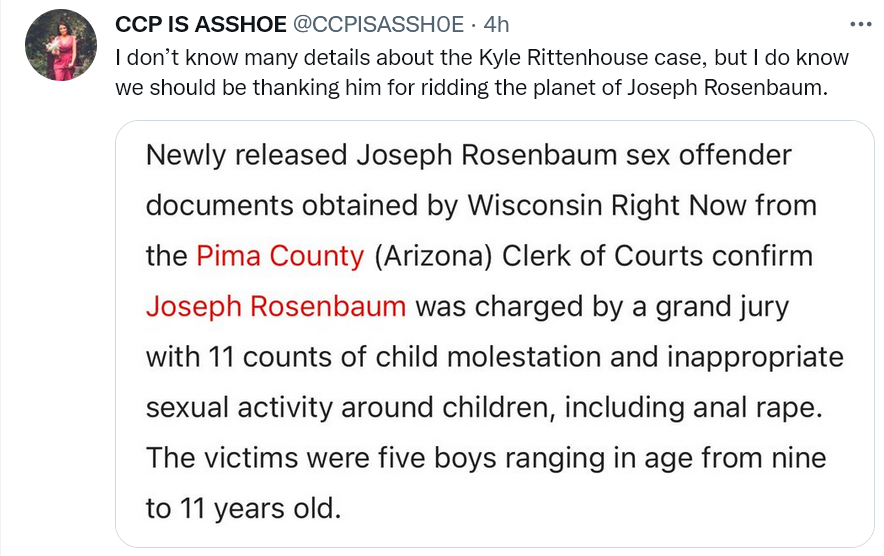it is rare, right?

17 men head to Chesterfield motel expecting to have sex with minors, met with police instead
The suspects range in age from 24 to 51 years old. They are from all over Virginia including, Richmond, Henrico, Chesterfield, Prince George, Louisa, Virginia Beach– even Maryland.www.wric.com
Join the Hide community
Get access to live stream, lessons, the post exchange, and chat with other snipers.
Register
Download Gravity Ballistics
Get help to accurately calculate and scope your sniper rifle using real shooting data.

Install the app
How to install the app on iOS
Follow along with the video below to see how to install our site as a web app on your home screen.
Note: This feature may not be available in some browsers.
You are using an out of date browser. It may not display this or other websites correctly.
You should upgrade or use an alternative browser.
You should upgrade or use an alternative browser.
PortaJohn
- Thread starter Lowlight
- Start date
-
- Tags
- sniper's hide
somebody had the nerve to ask why the clotshot is failing in israel, so they shut down the presser.

Jacinda Ardern ends press conference after being heckled over Covid vaccines – video
Ardern had to abruptly halt a media conference after being continuously interrupted and heckled by at least two people who appeared to be anti-vaxxerswww.theguardian.com
Arderns arrogance is off the charts.
If you watch right to the end she pretty much tells the people recording to rerecord the speech to ensure that no one has to listen to the person asking the awkward (but perfectly valid) questions.
When I see leaders like these it makes me angry but I take solace in knowing that every day they are getting closer to people finally seeing the light and kicking them to the curb.
unarmed?

The third guy he shot became unarmed.....

IT'S HAPPENING AGAIN - Judge In Virginia Dismisses Case - Allows Fairfax County to Include Absentee and Mail-In Ballots in Governor Election that Violate the Law | The Gateway Pundit | by Joe Hoft
Some things never change. Judges that won’t do what’s just and Democrats who steal elections. We reported previously that Virginia was not requiring the last 4 digits of social security numbers on absentee ballots. This is in direct violation of the law.
some of this is fucking hilarious
Last edited:
Youngkin will lose. Media will not cover it, they already know what the results will be. I'll be happy to say I was wrong if it goes the other way.
IT'S HAPPENING AGAIN - Judge In Virginia Dismisses Case - Allows Fairfax County to Include Absentee and Mail-In Ballots in Governor Election that Violate the Law | The Gateway Pundit | by Joe Hoft
Some things never change. Judges that won’t do what’s just and Democrats who steal elections. We reported previously that Virginia was not requiring the last 4 digits of social security numbers on absentee ballots. This is in direct violation of the law.www.thegatewaypundit.com
Privatizing public works is a great idea on paper, but has proven to be widely disastrous
You mean government-run utilities are a great thing?
Like in Puerto Rico?
HO. LI. FUCK.
From lawyer Robert Barnes
My Whistleblower Client Goes Public. The clinical trials for the Covid vaccines were a complete fraud.

 www.bmj.com
www.bmj.com
From lawyer Robert Barnes
My Whistleblower Client Goes Public. The clinical trials for the Covid vaccines were a complete fraud.

Covid-19: Researcher blows the whistle on data integrity issues in Pfizer’s vaccine trial
Revelations of poor practices at a contract research company helping to carry out Pfizer’s pivotal covid-19 vaccine trial raise questions about data integrity and regulatory oversight. Paul D Thacker reports In autumn 2020 Pfizer’s chairman and chief executive, Albert Bourla, released an open...
This is the best example!!
ASGH...sadly...HO. LI. FUCK.
From lawyer Robert Barnes
My Whistleblower Client Goes Public. The clinical trials for the Covid vaccines were a complete fraud.

Covid-19: Researcher blows the whistle on data integrity issues in Pfizer’s vaccine trial
Revelations of poor practices at a contract research company helping to carry out Pfizer’s pivotal covid-19 vaccine trial raise questions about data integrity and regulatory oversight. Paul D Thacker reports In autumn 2020 Pfizer’s chairman and chief executive, Albert Bourla, released an open...www.bmj.com
Purge of moral character

 www.militarytimes.com
www.militarytimes.com

The Corps’ COVID-19 vaccination deadline is coming. Marines who refuse will be booted
The Marine Corps has not approved any religious exemptions to the COVID-19 vaccine.

IT'S HAPPENING AGAIN - Judge In Virginia Dismisses Case - Allows Fairfax County to Include Absentee and Mail-In Ballots in Governor Election that Violate the Law | The Gateway Pundit | by Joe Hoft
Some things never change. Judges that won’t do what’s just and Democrats who steal elections. We reported previously that Virginia was not requiring the last 4 digits of social security numbers on absentee ballots. This is in direct violation of the law.www.thegatewaypundit.com
Legislature makes law....judiciary only interprets constitutionality and judges violations NOT aids and abets in breaking.
some of this is fucking hilarious
OK, so starting at 15:00 or so...I understand Rittenhouse was "underage" , but can we discuss his firearm handling skills?.. He cleared a jam, hitting an arm attached to a handgun pointed to execute him instead of going for center mass. This is very enlightening, you can see Rittenhouse actually was being a medic/putting out fires, and Rittenhouse did not fire the first shot...
Legislature makes law....judiciary only interprets constitutionality and judges violations NOT aids and abets in breaking.

What country do you live in?
Supposedly there is over 12k air force that didn't get it. Forget where I saw those numbers though.Purge of moral character

The Corps’ COVID-19 vaccination deadline is coming. Marines who refuse will be booted
The Marine Corps has not approved any religious exemptions to the COVID-19 vaccine.www.militarytimes.com
Doc
Supposedly there is over 12k air force that didn't get it. Forget where I saw those numbers though.
Doc
AF is sweating it because if they dont get it their loss will hurt operational ability.
Right now I say fuck it. Ground the whole air arm if need be.
Nothing focuses a people and eliminates bullshit more than an external threat coming to take advantage of our self inflicted weakness.

What country do you live in?
One that doesnt abide by its Constitution.......
Somedays.. I wonder just how much longer we are going to stand for this shit.

For years, the White Coat Waste Project was heralded by The Post as what they are: an activist success story uniting right and left. But now its work imperils a liberal icon.
Glenn Greenwald || Nov 2
Footage from “Inside the Barbaric U.S. Industry of Dog Experimentation,” May 17 2018, reported by Glenn Greenwald and Leighton Woodhouse for The Intercept
Anger over the U.S. Government's gruesome, medically worthless experimentation on adult dogs and puppies has grown rapidly over the last two months. A truly bipartisan coalition in Congress has emerged to demand more information about these experiments and denounce the use of taxpayer funds to enable them. On October 24, twenty-four House members — nine Democrats and fifteen Republicans, led by Rep. Nancy Mace (R-SC) — wrote a scathing letter to Dr. Anthony Fauci expressing “grave concerns about reports of costly, cruel, and unnecessary taxpayer-funded experiments on dogs commissioned by National Institute of Allergy and Infectious Diseases." Similar protests came in the Senate from a group led by Sen. Rand Paul (R-KY).
The campaign to end these indescribably cruel, taxpayer-funded experiments on dogs has been underway for years, long before Dr. Facui became a political lightning rod. In 2018, I reported on these experiments under the headline "BRED TO SUFFER: Inside the Barbaric U.S. Industry of Dog Experimentation.” That article described “a largely hidden, poorly regulated, and highly profitable industry in the United States that has a gruesome function: breeding dogs for the sole purpose of often torturous experimentation, after which the dogs are killed because they are no longer of use.”
Along with the videographer Leighton Woodhouse, I also produced a two-minute video report which used footage from experimentation labs filmed by activists with the animal rights group Direct Action Everywhere (DxE) to show the graphic, excruciating horrors to which these dogs are subjected (the video, which is hard to watch, is appended to the bottom of this article). In our reporting, we noted the cruel irony driving how and why particular dogs are selected for this short life of suffering and misery and detailed just some of the barbarism involved:
The majority of dogs bred and sold for experimentation are beagles, which are considered ideal because of their docile, human-trusting personality. In other words, the very traits that have made them such loving and loyal companions to humans are the ones that humans exploit to best manipulate them in labs. . . .
They are often purposely starved or put into a state of severe thirst to induce behavior they would otherwise not engage in. They are frequently bred deliberately to have crippling, excruciating diseases, or sometimes are brought into life just to have their organs, eyes, and other body parts removed and studied as puppies, and then quickly killed.
They are force-fed laundry detergents, pesticides, and industrial chemicals to the point of continuous vomiting and death. They are injected with lethal pathogens such as salmonella or rabies. They have artificial sweetener injected into their veins that causes the dogs’ testicles to shrink before they are killed and exsanguinated. Holes are drilled into their skulls so that viruses can be injected into their brains. And all of that is perfectly legal.
Most of these dogs, after being bred, are "devocalized,” which the advocacy group NAVS describes as “a surgical procedure which makes it physically impossible for the dog to bark.” Though entailing pain and suffering, the procedure prevents the dogs from screaming in pain. As we noted in that article, researchers acknowledge that few to none of these experiments are actually medically necessary. This 2016 op-ed in The San Diego Union-Tribune by Lawrence Hansen, a professor of neuroscience and pathology at the University of California-San Diego School of Medicine who once engaged in experimentation on dogs, explains why he is so ashamed to have participated given their medical worthlessness.
While numerous advocacy groups have been working for years to curb the abuses of these experiments, one group, White Coat Waste Project, has found particular success as a result of an innovative strategy. Advocacy groups know how polarized American politics has become, and that, as a result, a prerequisite for success is constructing a movement that can attract people from all ideologies, who identify with either or neither of the two political parties, but unite in defense of universally held values and principles.
White Coat has accomplished this with great success by fusing the cause of animal rights (long viewed as associated with the left) with opposition to wasteful taxpayer spending (a cause that resonates more on the right). The fact that love for dogs, and animals generally, has grown across all demographic groups further enables them to unite people from across the spectrum, including in Congress, in support of their cause. They routinely attract both Democratic and Republican members of Congress to sign on to their campaigns to end taxpayer-funded experimentation on animals, and are funded almost entirely through small-donor, grass-roots support that comes from the right, the left, and everything in between. Each year, they publicly award members of Congress “who have demonstrated outstanding leadership in the War on Waste, by exposing and stopping $20 billion in wasteful and unnecessary taxpayer-funded animal experiments,” and those honored are always a bipartisan group of lawmakers.
More than any other group, it is White Coat that has elevated the cause of stopping these horrific government experimentations on dogs and puppies into the mainstream political conversation. And numerous media outlets — led by The Washington Post — have spent years publishing flattering profiles on this group and its innovative bipartisan strategies. In November, 2016, for instance, The Post published reporting about White Coat's activities — under the headline: “Should dogs be guinea pigs in government research? A bipartisan group says no” — which heralded the group and its activists for being one of those rare Washington success stories that unites both left and right around a common cause:
To Protect Fauci, The Washington Post is Preparing a Hit Piece on the Group Denouncing Gruesome Dog Experimentations

For years, the White Coat Waste Project was heralded by The Post as what they are: an activist success story uniting right and left. But now its work imperils a liberal icon.
Glenn Greenwald || Nov 2
Footage from “Inside the Barbaric U.S. Industry of Dog Experimentation,” May 17 2018, reported by Glenn Greenwald and Leighton Woodhouse for The Intercept
Anger over the U.S. Government's gruesome, medically worthless experimentation on adult dogs and puppies has grown rapidly over the last two months. A truly bipartisan coalition in Congress has emerged to demand more information about these experiments and denounce the use of taxpayer funds to enable them. On October 24, twenty-four House members — nine Democrats and fifteen Republicans, led by Rep. Nancy Mace (R-SC) — wrote a scathing letter to Dr. Anthony Fauci expressing “grave concerns about reports of costly, cruel, and unnecessary taxpayer-funded experiments on dogs commissioned by National Institute of Allergy and Infectious Diseases." Similar protests came in the Senate from a group led by Sen. Rand Paul (R-KY).
The campaign to end these indescribably cruel, taxpayer-funded experiments on dogs has been underway for years, long before Dr. Facui became a political lightning rod. In 2018, I reported on these experiments under the headline "BRED TO SUFFER: Inside the Barbaric U.S. Industry of Dog Experimentation.” That article described “a largely hidden, poorly regulated, and highly profitable industry in the United States that has a gruesome function: breeding dogs for the sole purpose of often torturous experimentation, after which the dogs are killed because they are no longer of use.”
Along with the videographer Leighton Woodhouse, I also produced a two-minute video report which used footage from experimentation labs filmed by activists with the animal rights group Direct Action Everywhere (DxE) to show the graphic, excruciating horrors to which these dogs are subjected (the video, which is hard to watch, is appended to the bottom of this article). In our reporting, we noted the cruel irony driving how and why particular dogs are selected for this short life of suffering and misery and detailed just some of the barbarism involved:
The majority of dogs bred and sold for experimentation are beagles, which are considered ideal because of their docile, human-trusting personality. In other words, the very traits that have made them such loving and loyal companions to humans are the ones that humans exploit to best manipulate them in labs. . . .
They are often purposely starved or put into a state of severe thirst to induce behavior they would otherwise not engage in. They are frequently bred deliberately to have crippling, excruciating diseases, or sometimes are brought into life just to have their organs, eyes, and other body parts removed and studied as puppies, and then quickly killed.
They are force-fed laundry detergents, pesticides, and industrial chemicals to the point of continuous vomiting and death. They are injected with lethal pathogens such as salmonella or rabies. They have artificial sweetener injected into their veins that causes the dogs’ testicles to shrink before they are killed and exsanguinated. Holes are drilled into their skulls so that viruses can be injected into their brains. And all of that is perfectly legal.
Most of these dogs, after being bred, are "devocalized,” which the advocacy group NAVS describes as “a surgical procedure which makes it physically impossible for the dog to bark.” Though entailing pain and suffering, the procedure prevents the dogs from screaming in pain. As we noted in that article, researchers acknowledge that few to none of these experiments are actually medically necessary. This 2016 op-ed in The San Diego Union-Tribune by Lawrence Hansen, a professor of neuroscience and pathology at the University of California-San Diego School of Medicine who once engaged in experimentation on dogs, explains why he is so ashamed to have participated given their medical worthlessness.
While numerous advocacy groups have been working for years to curb the abuses of these experiments, one group, White Coat Waste Project, has found particular success as a result of an innovative strategy. Advocacy groups know how polarized American politics has become, and that, as a result, a prerequisite for success is constructing a movement that can attract people from all ideologies, who identify with either or neither of the two political parties, but unite in defense of universally held values and principles.
White Coat has accomplished this with great success by fusing the cause of animal rights (long viewed as associated with the left) with opposition to wasteful taxpayer spending (a cause that resonates more on the right). The fact that love for dogs, and animals generally, has grown across all demographic groups further enables them to unite people from across the spectrum, including in Congress, in support of their cause. They routinely attract both Democratic and Republican members of Congress to sign on to their campaigns to end taxpayer-funded experimentation on animals, and are funded almost entirely through small-donor, grass-roots support that comes from the right, the left, and everything in between. Each year, they publicly award members of Congress “who have demonstrated outstanding leadership in the War on Waste, by exposing and stopping $20 billion in wasteful and unnecessary taxpayer-funded animal experiments,” and those honored are always a bipartisan group of lawmakers.
More than any other group, it is White Coat that has elevated the cause of stopping these horrific government experimentations on dogs and puppies into the mainstream political conversation. And numerous media outlets — led by The Washington Post — have spent years publishing flattering profiles on this group and its innovative bipartisan strategies. In November, 2016, for instance, The Post published reporting about White Coat's activities — under the headline: “Should dogs be guinea pigs in government research? A bipartisan group says no” — which heralded the group and its activists for being one of those rare Washington success stories that unites both left and right around a common cause:
HO. LI. FUCK.
From lawyer Robert Barnes
My Whistleblower Client Goes Public. The clinical trials for the Covid vaccines were a complete fraud.

Covid-19: Researcher blows the whistle on data integrity issues in Pfizer’s vaccine trial
Revelations of poor practices at a contract research company helping to carry out Pfizer’s pivotal covid-19 vaccine trial raise questions about data integrity and regulatory oversight. Paul D Thacker reports In autumn 2020 Pfizer’s chairman and chief executive, Albert Bourla, released an open...www.bmj.com
Pfizer employee: Sir, Ventavia has been screwing up our trials. The data is useless....
CEO: Perfect
"Since Jackson reported problems with Ventavia to the FDA in September 2020, Pfizer has hired Ventavia as a research subcontractor on four other vaccine clinical trials (covid-19 vaccine in children and young adults, pregnant women, and a booster dose, as well an RSV vaccine trial; NCT04816643, NCT04754594, NCT04955626, NCT05035212). The advisory committee for the Centers for Disease Control and Prevention is set to discuss the covid-19 paediatric vaccine trial on 2 November."
‘It’s Free’: Pfizer & Moderna project tens of billions in COVID shot PROFITS
Jordan Schachtel - Investigative journalist.
In the COVID Era, your favorite mom-and-pop shops might be closed forever, but business is booming for Big Pharma, with COVID shot companies breaking record after record across the board.
With enormous profits siphoned off the backs of taxpayers around the world, and virtually zero legal liability with any of its customers, Pfizer, Moderna, and even Johnson & Johnson can’t lose. You, the American taxpayer, even paid for the research and development of the shots, but Big Pharma is still footing you with the bill and taking all of the profits.
Pfizer said in a statement today that the company is again revising its revenue targets upwards, estimating between $81 and $82 billion in revenue for 2021. Pfizer is now projected to double its 2020 revenue, when the pharma giant brought in $41.9 billion. In 2021, $36 billion will have come from sales of COVID shots that were developed in partnership with BioNTech. With an estimated 30% profit margin, the mRNA shots alone will bring in over $10 billion in profit.

Killing off the Zombie again: Joe Manchin drives another stake into Biden's Build Back Better agenda
It was the thing that wouldn't die, the thing that wouldn't go away... No, not the Halloween zombies and vampires, but Joe Biden's once, twice, now thrice dead Build Back Better agenda — with its twin porkulus infrastructure and ...
An acquaintance of mine is all set to get behind Manchin for POTUS. Then again he's spouted off Nikki Haley too (which would cause me to vote differently too) or Noem (a big let down recently).
Killing off the Zombie again: Joe Manchin drives another stake into Biden's Build Back Better agenda
It was the thing that wouldn't die, the thing that wouldn't go away... No, not the Halloween zombies and vampires, but Joe Biden's once, twice, now thrice dead Build Back Better agenda — with its twin porkulus infrastructure and ...www.americanthinker.com
But, I'm thankful it appears he's not sold out COMPLETELY; just 65-75%.
POTUS: Potatohead Of The United States is already predicting who is going to win Virginia. Bet he knows something we don't!
No he doesn't!!!! We ALL know the cheat is on already. In all probability, there will never be another fair election in the history of The USA and for sure there won't be another one in what was a Constitutional Republic known as The United STATES of America.POTUS: Potatohead Of The United States is already predicting who is going to win Virginia. Bet he knows something we don't!
Dominion has predicted that Terry McAuliffe will win tonight, but the results won't be known until tomorrow morning. They need time to count the mail in ballots after the poll watchers go home. 

BREAKING: Researchers In Peer-Reviewed Study Call For "IMMEDIATE WITHDRAWAL of mRNA COVID Vaccines For Use in Pregnancy, Those Breastfeeding, Those Of Childbearing Age and Children" * 100PercentFedUp.com * by Patty McMurray
BREAKING…After re-analyzing a study performed by Centers for Disease Control and Prevention (CDC) researchers, a peer-reviewed study has called for […]
dead people or nursing homes?


Bob said sorry. WTF?
madison is dead, like this piece of shit's political career.

Patriot Purge Part 2 – Tucker Carlson Originals
Part 1 Part 2 Part3 The Biden regime has launched one of the largest manhunts in history. Tucker and his team talk to patriots that kicked in the doors of terrorists that are now having their doors kicked in by the state they once served.
Similar threads
- Replies
- 1
- Views
- 505










